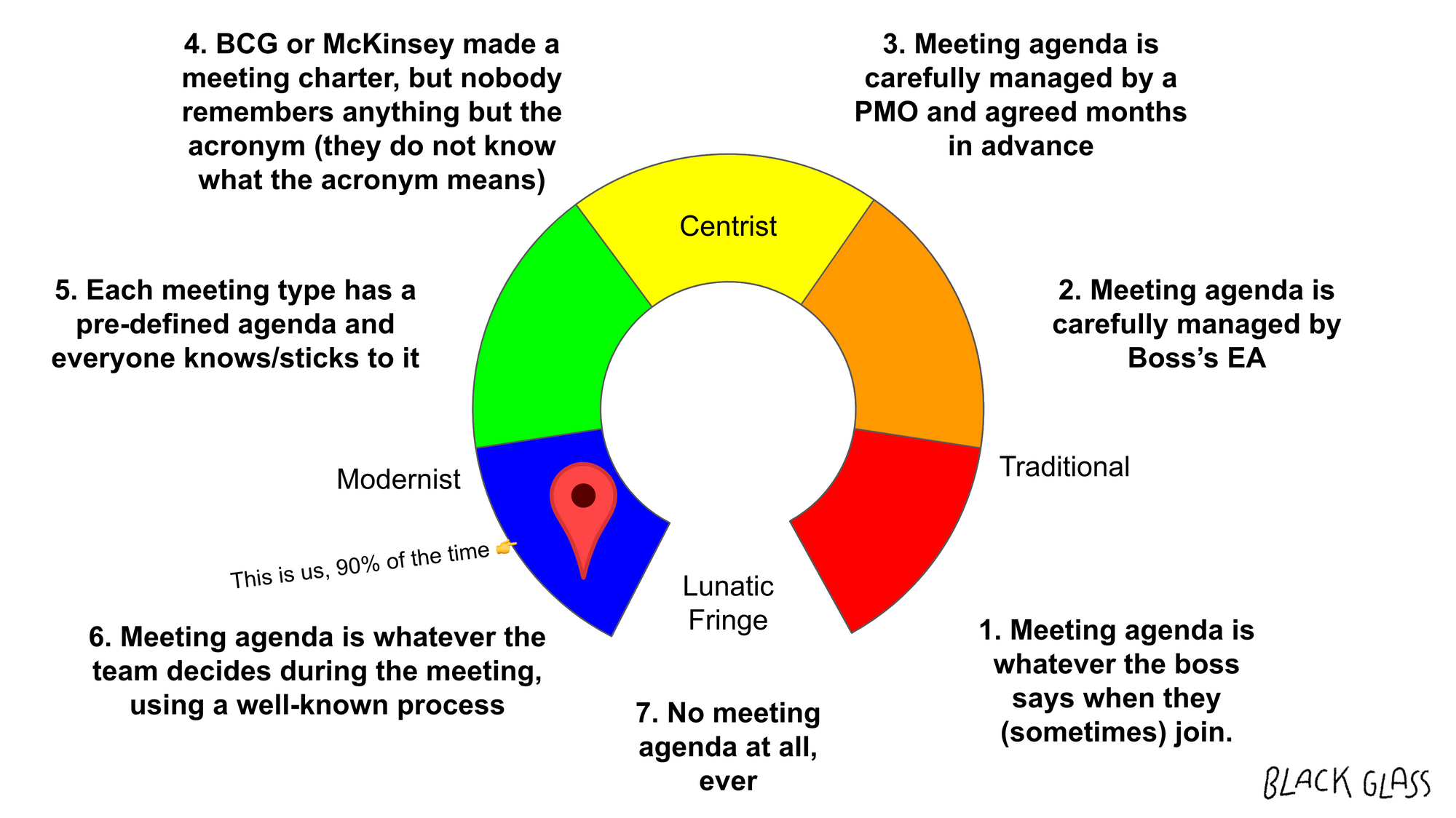Introducing The Meeting Agenda Horseshoe Theory

We have a confession to make.
We tend to not add meeting agendas to our internal team invites.

We know. We know.
One of the most recommended ways of working is 📣"Every meeting needs an agenda" 📣 - how could we not adopt the practice for ourselves?
Enter: The Meeting Agenda Horseshoe Theory
While it may not be best practice to ignore agendas altogether, it also may not be a true indicator or efficiency and may actually also be a sign of a highly functioning team.
There's NUANCE, people!
Here’s the way we see the meeting agenda spectrum:

Let’s start all the way on the bottom-right, and work counterclockwise.
1. Meeting agenda is whatever the boss says when they (sometimes) join
Planning? Performance Results? Budget? Your guess is as good as ours. So buckle up and hang on for the ride! In our experience, most working teams are somewhere in this zone, most of the time.

2. Meeting agenda is carefully managed by Boss's EA
Let's pour one out for all of the EAs who never got the inputs into the agenda. Or for the EA who has to fend off dueling SVPs who never agree on a single thing. We often see these turning into Agendas In Name Only (AINOs?), as the team slips back down the spectrum.
3. Meeting agenda is carefully managed by a PMO and agreed to months in advance.
You know what we’re going to say here. This feels professional, but it’s also the case that you’re now working on issues that are months old.
4. BCG or McKinsey made a meeting charter, but nobody remembers anything but the acronym (they do not know what the acronym means)
"We knew what [insert acronym here] stood for at one point..." or our personal favorite, "Well I think it means x, but most people think it means y.”
But look, we have a charter. (Pro-tip: go search for the acronym in your drive).
5. Each meeting type has a pre-defined agenda and everyone knows/sticks to it
Process with just a sprinkle of the unknown. Chef’s kiss.
At some point, someone (or a group of someones) made the decision around the purpose of the meetings and started operating against those decisions. This could be you, tomorrow, if you take an hour and Write. Stuff. Down.
Bonus points: save all the meetings, attendees and agendas in your onboarding and training materials. For the children.
6. Meeting agenda is whatever the team decides during the meeting, using a well-known process
Our meetings look agenda-less to the untrained eye. This works for us for two reasons: we’re deeply aligned on our priorities, and we don’t rely on meetings to get work done. So if something important is not on the agenda, that’s ok.
Tools, ways of working and team culture are key enablers here. Want to do this and have it not be terrible?
You must work in public. You must use shared files. You must actively encourage people not to attend meetings that they don’t need to. But look out: high turnover, mission drift, loss of empowerment or decision rights – all of these can pull you down into…

7. Lunatic Fringe - No meeting agenda at all, ever
Meetings are added to calendars – and it’s anybody’s guess what will be discussed.
Even worse, there may be little to no capture of action items or next steps when the meeting is done. (This job tends to fall to the person in the room with the least privilege.)
So...where to go from here?
Your best bet is to start moving a little bit counter-clockwise with time and repetition. You’ve got to get good at collectively bringing forward and prioritizing agenda topics without descending into chaos.
But with some practice, communication and the right partner, you too can thrive without an agenda.





